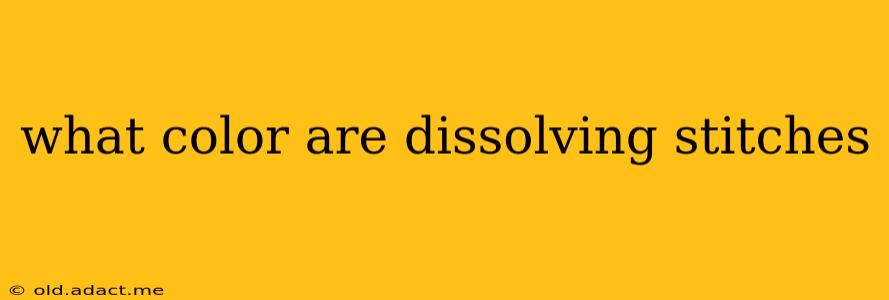What Color Are Dissolving Stitches?
The color of dissolving stitches, also known as absorbable sutures, isn't a single, definitive answer. This is because the color can vary depending on the specific material used and the manufacturer. While some are clear or colorless, many are available in various shades, including:
- Purple: A common color for absorbable sutures.
- Black: Also frequently used.
- Clear/Transparent: Some dissolving stitches are virtually invisible, blending in with the surrounding skin.
The color itself doesn't affect the suture's ability to dissolve. The dissolving process is determined by the material composition – usually a synthetic polymer like polyglycolic acid (PGA) or polylactic acid (PLA), or a natural material like catgut (made from collagen). These materials are gradually broken down and absorbed by the body over time, eliminating the need for suture removal.
It's important to note that while the stitches themselves may dissolve, the initial appearance of the suture can influence how noticeable they are, especially on lighter skin tones.
What Determines the Color of Dissolving Stitches?
The color is typically added during the manufacturing process, often using dyes that are also biocompatible and safe for the body. The choice of color can be influenced by factors such as:
- Visibility: Different colors might be chosen depending on the location of the wound and the ease with which the surgeon needs to visualize the sutures during surgery. A darker color might be preferred in certain surgical sites.
- Manufacturer Preference: Different manufacturers may use their own distinct color codes or preferences.
Are There Different Types of Dissolving Stitches?
Yes, many types of dissolvable stitches exist, categorized based on the material used and the absorption rate. These differences affect not only their color (as explained above) but also their strength and the time it takes for them to dissolve completely. Some dissolve within weeks, while others take months. This is determined by the surgeon based on the healing needs of the specific wound.
How Long Do Dissolving Stitches Take to Dissolve?
The time it takes for dissolving stitches to completely disappear depends on factors including:
- The type of suture material used: Different materials have different absorption rates.
- The location of the wound: Wounds in areas with good blood supply tend to heal faster and the sutures dissolve more quickly.
- Individual healing factors: Each person's body reacts differently, influencing the rate of absorption.
Your surgeon can provide specific information about the type of dissolving stitches used, their anticipated absorption time, and any potential post-operative care instructions.
Why Are Some Stitches Not Dissolving?
If it appears your stitches are not dissolving as expected, it is crucial to contact your doctor or surgeon. There are several possibilities, including:
- Non-absorbable sutures were used: Some surgical procedures require non-dissolving stitches, that need to be removed by a medical professional.
- Infection: Infection can delay or inhibit the dissolving process.
- Material Properties: Certain materials may take a significantly longer time than originally anticipated.
Never attempt to remove dissolving stitches yourself. Always consult a medical professional for any concerns regarding the healing process.
Remember, this information is for educational purposes only and should not be considered medical advice. Always consult a healthcare professional for any health concerns or before making any decisions related to your health or treatment.
